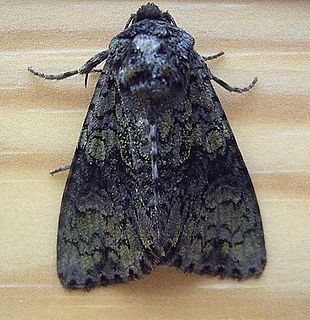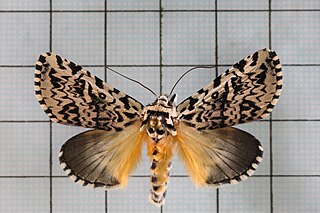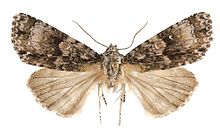
The Noctuidae, commonly known as owlet moths, cutworms or armyworms, are the most controversial family in the superfamily Noctuoidea because many of the clades are constantly changing, along with the other families of the Noctuoidea. It was considered the largest family in Lepidoptera for a long time, but after regrouping Lymantriinae, Catocalinae and Calpinae within the family Erebidae, the latter holds this title now. Currently, Noctuidae is the second largest family in Noctuoidea, with about 1,089 genera and 11,772 species. However, this classification is still contingent, as more changes continue to appear between Noctuidae and Erebidae.

Craniophora ligustri, the coronet, is a moth of the family Noctuidae. The species was first described by Michael Denis and Ignaz Schiffermüller in 1775. It is found in Europe, through the Palearctic to Japan.

Mythimna separata, the northern armyworm, oriental armyworm or rice ear-cutting caterpillar, is a moth of the family Noctuidae. It is found in China, Japan, South-east Asia, India, eastern Australia, New Zealand, and some Pacific islands. It is one of the major pests of maize in Asia. The species was first described by Francis Walker in 1865.

Craniophora is a genus of moths of the family Noctuidae.

Dictyestra is a monotypic moth genus of the family Noctuidae erected by Shigero Sugi in 1982. It contains only one species, Dictyestra dissectus, the angle network armyworm, first described by Francis Walker in 1865. It is found from India to Indochina, Sri Lanka, China, Japan, Sundaland and the Philippines and from Sulawesi to the Moluccas and New Guinea.

Lygephila is a genus of moths in the family Erebidae. The genus was erected by Gustaf Johan Billberg in 1820.

Niphonyx is a monotypic moth genus of the family Noctuidae erected by Shigero Sugi in 1982. Its only species, Niphonyx segregata, the hops angleshade, was first described by Arthur Gardiner Butler in 1878. It is endemic to eastern Asia, including the Russian Far East, the Korean Peninsula, Japan, China and Taiwan. It was introduced to the north-eastern United States in the 1990s and is found from Connecticut south to at least Delaware.

Catocala agitatrix is a moth of the family Erebidae. It is found in the Russian Far East, China, Korea, Japan.

Leucania loreyi, the cosmopolitan, false army worm or nightfeeding rice armyworm, is a moth of the family Noctuidae. It is found in most of African countries, the Indo-Australian subtropics and tropics of India, Sri Lanka, Myanmar, the eastern Palearctic realm, and the Near East and Middle East. The species was first described by Philogène Auguste Joseph Duponchel in 1827.

Trichosea champa is a moth of the family Noctuidae first described by Frederic Moore in 1879. It is found in the Himalayas, north-east India, Sri Lanka, China, Taiwan, Japan, and Russia.

Spodoptera mauritia, the lawn armyworm or paddy swarming caterpillar, is a moth of the family Noctuidae. The species was first described by Jean Baptiste Boisduval in 1833. Able to eat many types of food, it is a major pest throughout the world.

Tiracola plagiata, the cacao armyworm, is a moth of the family Noctuidae. The species was first described by Francis Walker in 1857. It is found from south-east Asia, South India, Sri Lanka, Myanmar to the South Pacific Islands, including the northern two-thirds of Australia.

Craniophora harmandi is a moth of the family Noctuidae. It is found in Japan, They emerge as adults between June and September in Japan. Nepal, and the western Himalaya to Taiwan "in the region with monsoonic influence."

Zanclognatha reticulatis is a species of litter moth of the family Erebidae. It was described by John Henry Leech in 1900. It is found in Taiwan, Japan and the Kuriles.
Scopula modicaria is a moth of the family Geometridae. It was described by John Henry Leech in 1897. It is found in China, the Russian Far East, Korea and Japan.

Craniophora fujianensis is a moth of the family Noctuidae, named for the Fujian province where it was discovered in 2004. The species is found in Fujian and Hainan Provinces in China, but the nominate subspecies is found only in Fujian, and subspecies C. f. hainanensis is restricted to Hainan.

Craniophora sichuanensis is a moth of the family Noctuidae. It is found in China (Sichuan). The habitat consists of virgin mixed forests.
Agonopterix taciturna is a moth in the family Depressariidae. It was described by Edward Meyrick in 1910. It is found in the Himalayas, the Russian Far East and Japan.

Craniophora fasciata is a moth of the family Noctuidae first described by Frederic Moore in 1884. It is found in Sri Lanka, Japan, Korea, Taiwan, Thailand and Australia.
Trisula variegata is a moth of the family Noctuidae first described by Frederic Moore in 1858. It is found in India, Sri Lanka, Nepal, Thailand, South China, Indonesia and the Philippines.

















